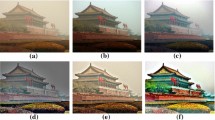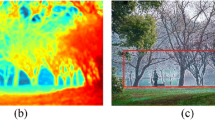Abstract
In the popular atmospheric scattering model applied to image dehazed, the scatter from the adjacent light sources on the camera sensor which has degraded the image quality is neglected, especially when some artificial light sources exist. Therefore, in the dehazing results, the light sources are always much brighter than those in the original image in order to enhance the majority details in the dark regions, which causes the details around the light sources to be obscured. We propose a novel image restoration model mainly based on point light source multiple scattering theory. An observed hazed image can be described as a linear combination of light being reflected from an imaged object itself and its multiple scattering component. The restoration quality of the artificial light sources and details around them may be improved by suppressing the multiple scattering which can be simulated by an APSF function. The key of our model is to find the appropriate APSF kernels by analysis and some experiments. Comparisons and evaluations of our restoration results with those from popular algorithms show that ours is better in details and colors recovery in dealing with light sources in nighttime hazed images.








Similar content being viewed by others
References
He, K., Sun, J., Tang, X.: Single image haze removal using dark hannel prior. In: Computer Vision and Pattern Recognition, pp. 1956–1963 (2009)
Bahat, Y., Irani, M.: Blind dehazing using internal patch recurrence. In: European Conference on Computer Vision (ICCP), pp. 783–798 (2016)
Berman, D., Treibitz, T., Avidan, S.: Non-local image dehazing. In: IEEE Conference on Computer Vision and Pattern Recognition (CVPR), pp. 1674–1682 (2016)
Fattal, R.: Dehazing using color-lines. ACM Trans. Graph. 34(1), 1–14 (2014)
Fattal, R.: Single image dehazing. ACM Trans. Graph. 27(3), 1–9 (2008)
Gao, Y., Hu, H.-M., Wang, S., Li, B.: A fast image dehazing algorithm based on negative correction. Sig. Process. 103, 380–398 (2014)
He, K., Sun, J., Tang, X.: Single image haze removal using dark channel prior. In: IEEE Conference on Computer Vision and Pattern Recognition (CVPR), pp. 1956–1963 (2009)
Kim, J.-H., Jang, W.-D., Sim, J.-Y., Kim, C.-S.: Optimized contrast enhancement for real-time image and video dehazing. J. Vis. Commun. Image Represent. 24(3), 410–425 (2013)
Li, Z., Zheng, J.: Edge-preserving decomposition-based single image haze removal. IEEE Trans. Image Process. 24(12), 5432–5441 (2015)
Meng, G., Wang, Y., Duan, J., Xiang, S., Pan, C.: Efficient image dehazing with boundary constraint and on textual regularization. In: The IEEE International Conference on Computer Vision (ICCV), pp. 617–624 (2013)
Shi, Z., Long, J., Tang, W., Zhang, C.: Single image dehazing in inhomogeneous atmosphere. Optic 125(15), 3868–3875 (2014)
Shiau, Y.-H., Chen, P.-Y., Yang, H.-Y., Chen, C.-H., Wang, S.-S.: Weighted haze removal method with halo prevention. J. Vis. Commun. Image Represent. 25(2), 445–453 (2014)
Tan, R.: Visibility in bad weather from a single image. In: IEEE Conference on Computer Vision and Pattern Recognition (CVPR), pp. 1–8 (2008)
Zhu, Q., Mai, J., Shao, L.: A fast single image haze removal algorithm using color attenuation prior. IEEE Trans. Image Process. 24(11), 3522–3533 (2015)
Cai, B., Xu, X., Jia, K., Qing, C., Tao, D.: Dehaze net: an end-to-end system for single image haze removal. IEEE Trans. Image Process. 25(11), 5187–5198 (2016)
Ren, W., Liu, S., Zhang, H., Cao, X., Pan, J., Yang, M.-H.: Single image dehazing via multi-scale convolutional neural networks. In: European Conference on Computer Vision (ECCV), pp. 154–169 (2016)
Middleton, W.E.K.: Vision Through the Atmosphere. University of Toronto Press 10(48), 254–287 (1952)
Lee, J.S., Li, C.H., Lee, H.Y.: Visibility dehazing based on channel-weighted analysis and illumination tuning. Multimed. Tools Appl. 78(2), 1831–1856 (2019)
Gu, Y., Yang, X., Gao, Y.: A novel total generalized variation model for image dehazing. J. Math. Imaging Vis. 61(9), 1329–1341 (2019)
Yousaf, R.M., Habib, H.A., Mehmood, Z., et al: Single image dehazing and edge preservation based on the dark channel probability-weighted moments. Mathematical Problems in Engineering (2019)
Yue, B., Liu, K., Wang, Z., et al.: Accelerated haze removal for a single image by dark channel prior. Front. Inf. Technol. Electron. Eng. 20(8), 1109–1118 (2019)
Yan, J., Li, C., Zheng, Y., et al.: MMP-net: a multi-scale feature multiple parallel fusion network for single image haze removal. IEEE Access 8, 25431–25441 (2020)
Wang, W., Wang, A., Ai, Q., et al.: AAGAN: enhanced single image dehazing with attention-to-attention generative adversarial network. IEEE Access 7, 173485–173498 (2019)
Chen, W.T., Ding, J.J., Kuo, S.Y.:PMS-net: robust haze removal based on patch map for single images. In: IEEE Conference on Computer Vision and Pattern Recognition (CVPR), pp. 11681–11689 (2019)
Yang, D., Sun, J.: Proximal dehaze-net: a prior learning-based deep network for single image dehazing. In: European Conference on Computer Vision(ECCV), pp. 702–717 (2018)
Xiao, J., Shen, M., Lei, J., et al: Single image dehazing based on learning of haze layers. Neurocomputing (2020)
Pei, S.C., Lee, T.Y.: Nighttime haze removal using color transfer pre-processing and dark channel prior. In: IEEE International Conference on Image Processing (ICIP), pp. 957–960 (2012)
Zhang, J., Cao, Y., Wang, Z.: Nighttime haze removal based on a new imaging model. In: IEEE International Conference on Image Processing (ICIP), pp. 4557–4561 (2014)
Li, R., Tan, T., Brown, M.S.: Nighttime haze removal with glow and multiple light colors. In: IEEE International Conference on Computer Vision (ICCV), pp. 226–234 (2015)
Tang, C., Dong, Y., Sun, X., et al.: Image restoration algorithm for single nighttime weakly illuminated haze image. J Comput-Aided Des Comput Graph. 30(3), 467 (2018)
Ancuti, C., Ancuti, C.O. Christophe De, etc: Night-time dehazing by fusion. In: IEEE International Conference on Image Processing (ICIP), pp. 2256–2260 (2016)
Zhang, J., Cao, Y., Fang, S., Kang, Y., et al.: Fast haze removal for nighttime image using maximum reflectance prior. In: IEEE Conference on Computer Vision and Pattern Recognition (CVPR), pp. 7016–7024 (2017)
Yu, T., Song, K., Miao, P., et al.: Nighttime single image dehazing via pixel-wise alpha blending. IEEE Access 7, 114619–114630 (2019)
Kuanar, S., Rao, K.R., Mahapatra, D., et al: Night time haze and glow removal using deep dilated convolutional network. Preprint arXiv:1902.00855 (2019)
Narasimhan, S.G., Ramamoorthi, R., Nayar, S.K.: Analytic rendering of multiple scattering in participating media. Technical report (2004)
Wangping Rong, X.: Computing atmospheric point spread function by Monte_Carlo Method. J. Remote Sens. 3(4), 268–278 (1999)
Metari, S., Deschenes, F.: A New convolution kernel for atmospheric point spread function applied to computer vision. In: IEEE International Conference on Computer Vision, pp. 1–8 (2007)
Kyba, C.C.M., Ruhtz, T., Fischer, J., H¨olker, F.: Red is the new black: how the colour of urban skyglow varies with cloud cover. In: Monthly Notices of the Royal Astronomical Society (2012)
Acknowledgements
Thanks for Professor Yu Li, Jing Zhang and Yang Cao providing us their codes and synthesized image to test and comparison.
Author information
Authors and Affiliations
Corresponding author
Additional information
Publisher's Note
Springer Nature remains neutral with regard to jurisdictional claims in published maps and institutional affiliations.
Rights and permissions
About this article
Cite this article
Tang, C., Sun, R., Lian, Z. et al. PLSMS model for restoration of the details concealed by light sources in nighttime hazed image. SIViP 15, 411–419 (2021). https://doi.org/10.1007/s11760-020-01761-w
Received:
Revised:
Accepted:
Published:
Issue Date:
DOI: https://doi.org/10.1007/s11760-020-01761-w




